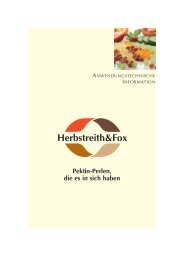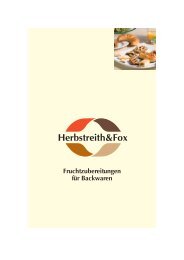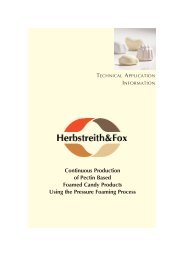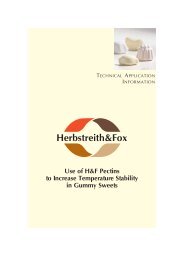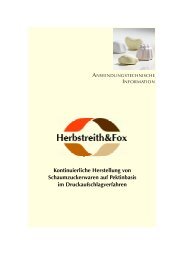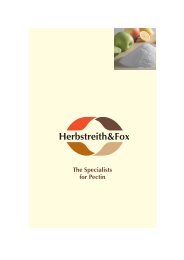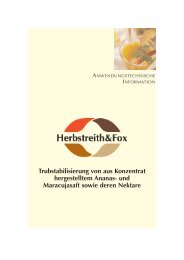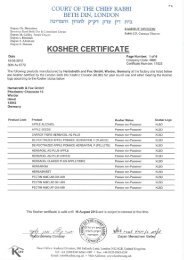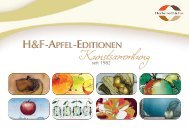Yoghurt Fruit Preparations - Herbstreith & Fox
Yoghurt Fruit Preparations - Herbstreith & Fox
Yoghurt Fruit Preparations - Herbstreith & Fox
You also want an ePaper? Increase the reach of your titles
YUMPU automatically turns print PDFs into web optimized ePapers that Google loves.
specific Benefits<br />
of H&F Apple Pectins<br />
When yoghurt fruit preparations are manufactured<br />
with H&F pectins, the aim is to achieve<br />
specific gelling properties that result in products<br />
which are easy to process and which have a<br />
regenerative, smooth and supple texture with<br />
a yield point.<br />
The role of pectin as a gelling agent is to form<br />
a network and to bind water.<br />
If, during the manufacturing of the gels and<br />
their further processing, the water-binding<br />
effect is not achieved or is destroyed by mechanical<br />
stress, the gel tends to contract and to<br />
release liquid – the gel displays syneresis.<br />
Syneresis is an undesirable effect that is observed<br />
in particular in pre-gelled products where<br />
the gel network has already been destroyed by<br />
mechanical stress.<br />
Pectins, such as Low Methylester Classic Apple<br />
Pectins and Low Methylester Amid Apple<br />
Pectins from H&F, to a high degree meet the<br />
requirement to prevent the occurrence of<br />
syneresis as far as possible.<br />
This is possible as these pectins are able to<br />
produce special rheological gel properties.<br />
Pectins form visco-elastic gels, whereby the<br />
main part is elastic, the smaller part viscous.<br />
The higher the viscous portion of the gel, the<br />
more resistant the gel is to mechanical stress<br />
and the lower its tendency to syneresis.<br />
H&F apple pectins in particular have the capacity<br />
to form elastic gels of relatively high viscous<br />
shares.<br />
The ratio between elastic and viscous share in<br />
a gel of otherwise identical formulation parameters<br />
is mostly determined by the degree of<br />
esterification of the pectin, its reactivity towards<br />
polyvalent ions, the raw material used and the<br />
pectin manufacturing process.<br />
The higher the degree of esterification and the<br />
higher the ion sensitivity of the pectin, the<br />
more predominant the elastic parts in the gel<br />
will be. With increasing elastic shares, the product<br />
becomes more brittle and therefore more<br />
sensitive towards mechanical stress, and the<br />
tendency to syneresis increases.<br />
Depending on certain enzyme activities in the<br />
raw material and the manufacturing method,<br />
the distribution of the free carboxyl groups<br />
over the molecule can be block-wise or random.<br />
If the free carboxyl groups, on account of the<br />
raw material and the gentle manufacturing<br />
method, are randomly distributed over the<br />
molecule – as is the case with H&F apple<br />
pectins – this results in pectins which are able to<br />
form visco-elastic gels with comparably high<br />
viscous shares.<br />
Therefore, fruit preparations manufactured<br />
with H&F apple pectins distinguish themselves<br />
not only by their outstanding processing properties<br />
and smooth, regenerative texture but<br />
are notable for their high resistance to mechanical<br />
stress and their extremely low tendency<br />
to syneresis.<br />
45<br />
Pectins in <strong>Yoghurt</strong> <strong>Fruit</strong> <strong>Preparations</strong>



